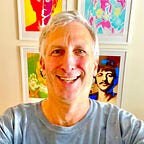THE GREATEST SONGS OF THE 1960s THAT NO ONE HAS EVER HEARD
Get Hoisted By Germany’s Own Petards!
The Petards — “Rainbows and Butterflies”
Get hoisted by Germany’s own Petards with this ’68 B-side, a pop-psych masterpiece and “psychedelically-propelled opus” (liner notes to the CD comp Electric Sound Show: An Assortment of Antiquities for the Psychedelic Connoisseur). The band recorded the #1 in Germany A-side “in only 30 minutes [but today’s song] needed 14 hours”!
The band’s website tells us (courtesy of Google Translate) that:
The Petards were one of the most successful and popular bands of the Beat era in Germany in the 1960s, alongside bands like “The Lords” (see #335) and “The Rattles”. In its founding year in 1966, the original formation of the Petards consisted of Horst and Klaus Ebert, Rüdiger “Roger” Waldmann and Hans Jürgen Schreiber, who was replaced in June 1967 by Arno Dittrich — considered Germany’s best drummer at the time. Arno literally put the listeners into a trance with his solos. With him they won the SWF’s young talent competition. This enabled them to record their first LP “A Deeper Blue”. Their singles “Shoot Me Up To The Moon” and the follow-up “Golden Glass” took first place on . . . the SWF hit parade. In 1968 their second LP “Petards” was released with the №1 hit “Pretty Liza”. Th[at] year they [also] produced their single “Misty Island,” a sophisticated catchy tune that is still considered a classic of the Beat era. They toured through Germany and gave a few concerts in what was then the [USSR]. . . . In the pop poll survey conducted by the magazine “Musikexpress” they were voted the “best young group”. Their album reached 5th place in the “LP of the Year” evaluation. The group also produced cover LPs under pseudonyms such as ZONK and FLITTERMOUSE, for example with songs from Creedence Clearwater Revival. [Their] third LP “Hitshock” was released in 1970. Appearances on French television and in “Olympia” in Paris followed. Their single “Blue Fire Light” made it into the top ten of the French and Belgian charts. The boys also showed their musical versatility when staging a musical (Shakespeare) at the theater in the Hanseatic city of Bremen. As the organizer of the legendary “Burg Herzberg Festival,” the band started a tradition that continues to this day. At the debut in 1970, over 5,000 visitors came to see the stars of progressive German rock from CAN to FRUMPY to AMON DÜÜL II. At the end of 1970, the PETARDS said goodbye to Klaus Ebert, who went to Hamburg as label manager. As a replacement for Klaus, the band chose guitarist Bernd Wippich from 60 applicants, who played an ingenious “Hendrix guitar”. The double album “Pet-Arts” (Favorite Arts) was released at the beginning of 1971 as one of their best and most creative with lovingly sophisticated songs . . . . [O]n September 3, 1972, the Petards unpacked their instruments for the last time in the Western Saloon in Wiesbaden.
Tre Roland enthuses:
The Petards, one of Germany’s most successful beat-turned-innovative kind of psychedelic rock and pop bands, are absolutely marvelous musicians! . . . Having its origins in Schrecksbach, located in the Schwalm-Eder District in the State of Hesse, The Petards (whose name is derived from the French for “bullfrog,”* making the German name Die Knallfrösche an alternate name for the group) were the brainchild of two guitar-playing brothers, Horst and Klaus Ebert. Before The Petards . . . Horst and Klaus formed . . . The Magic Stompers, who were more of Dixieland and Skiffle styles, complete with cover songs. After The Petards were formed, they literally kicked things off by recording the ear-slaying, distortion-fueled garage rock of “Baby Run Run Run,” before producing more Beatlesque tunes such as the awesomeness that is “Right Time.” Note that the shrillness of the band’s early, garage rock-focused sound had actually caused them to be taken to court in Treysa for disturbing the peace! They even played a concert before the judge! The music of The Petards is a sonic dinner of multiple courses, consisting of songs in the manner of garage rock, beat, pop rock, psychedelia, hard rock and even prog. The band’s more poppier, light-hearted side is found in songs such as their first major hit single, “Shoot Me Up to the Moon,” as well as “Golden Glass” and “Misty Island.” On the flip side of that coin, they were able to produce more guitar-focused, hard rocking material on tracks such as “Keep On,” “Stone By Now,” “Good Good Donna.” . . .
* I thought it meant firecracker in French.
See my website at bracefortheobscure60srock.com.
